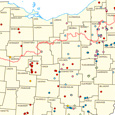The impact of Marcellus Shale development on housing
Tuesday, March 3, 2015

The Center for Rural Pennsylvania commissioned a Marcellus Shale Impacts study, the fifth looking at impacts on Pennsylvania schools and education.
Focus of study
Marcellus Shale development brings gas company workers, subcontractors and workers in related areas to the locations in which natural gas exploration and drilling occur. An immediate issue is where to house these workers. The fifth impacts study examines housing. This includes looking at housing stock (numbers and age of housing units), rental and vacancy rates, housing costs, and housing affordability in the four study counties of Bradford, Greene, Lycoming, and Washington.
Housing was identified as an important topic because of the influx of gas industry and related workers that has resulted from Marcellus Shale development. The report uses data from the 2000 U.S. Census of Population and Housing and the American Community Survey (2005/07 and 2009/11), collected by the U.S. Census Bureau, as well as qualitative data from focus groups with individuals knowledgeable about housing in the four counties.
Findings
The main findings demonstrate no obvious patterns in change in housing stock (actual numbers of housing units) related to Marcellus Shale activity. The factors affecting demand for housing did differ across the study counties. The decade saw an increase in the percentage of renters paying 30 percent or more of their income for their housing, but this was not clearly associated with Marcellus activity or population size. This, however, may reflect the displacement of poorer families unable to afford new higher rents. Low income families leaving these areas because of higher rents was described in the focus groups and in other studies (Williamson and Kolb 2011).
Focus groups also identified low income families and gas workers using temporary housing (e.g., motels or hotels or travel trailers), but data on this type of housing is limited at the county level as these are not counted as housing units in the U.S. Census or the American Community Survey. Homelessness also was identified as an issue affecting low income individuals and families who could no longer afford rent. Individuals in focus groups held in the study counties, described an increase in use of homeless shelters, and people living in cars and tents, moving in with friends and relatives or leaving the area.
Overall, the data identify the impacts of the gas industry and gas-related workers who move into the area to live in rental units or purchase homes, but it is difficult to determine how many of these workers remain in an area long-term, especially among those who move with the active drilling, pipeline and construction operations. Finally, while all four counties experienced gains in median household values, the values and their rate of appreciation were below the state average.
To access the reports, please go to the Center for Rural Pennsylvania’s website.




